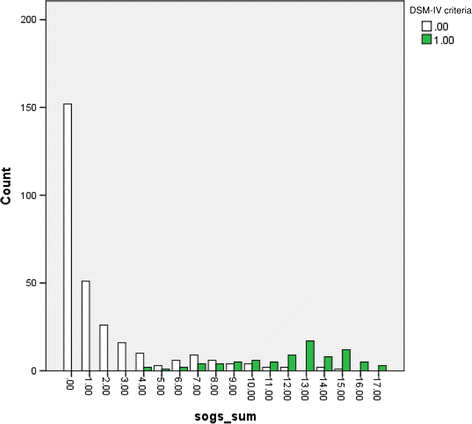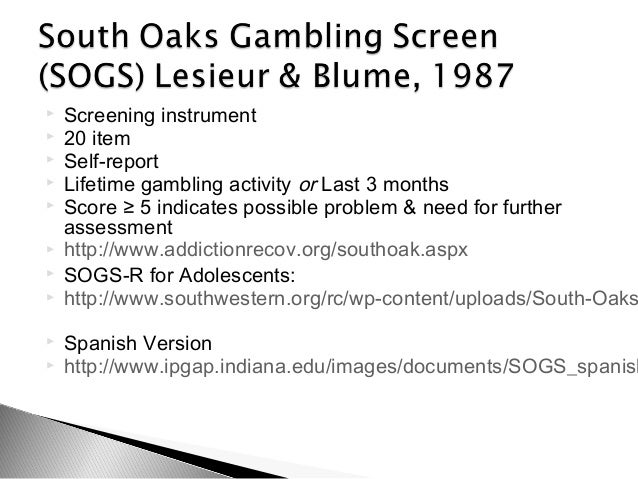- Abbott, M., & Volberg, R. A. (1991). Gambling in New Zealand-Report to the New Zealand Department of Internal Affairs.Google Scholar
- Abbott, M., & Volberg, R. A. (1992). Frequent Gamblers and Problem Gamblers in New Zealand: Report on Phase Two of the National Survey-Report to the New Zealand Department of Internal Affairs.Google Scholar
- Abbott, M. W., & Volberg, R. A. (1996). The New Zealand National Survey of problem and pathological gambling. Journal of Gambling Studies, 12(2), 143–160.Google Scholar
- Allcock, C. (1995). Some ponderings on pathological gambling: An introspective essay. Paper presented at the Sixth National Conference of the National Association for Gambling Studies, Sydney.Google Scholar
- Allcock, C. C., & Grace, D. M. (1988). Pathological gamblers are neither impulsive nor sensationseekers. Australia & New Zealand Journal of Psychiatry, 22(3), 307–11.Google Scholar
- American Psychiatric Association. (1980). Diagnostic & Statistical Manual 3rd edition. Washington, DC: Author.Google Scholar
- American Psychiatric Association. (1987). Diagnostic and statistical manual of mental disorders, Third edition, revised, DSM-III-R. Washington, DC: Author.Google Scholar
- American Psychiatric Association. (1994). Diagnostic and Statistical Manual IV. Washington, DC: Author.Google Scholar
- Andrews, G. H. C. (1998). Treatments that work in anxiety disorders. [Review]. Medical Journal of Australia, 168(12), 628–34.Google Scholar
- Baron, E., Dickerson, M., & Blaszczynski, A. (1995). The Scale of Gambling Choices: Preliminary development of an instrument to measure impaired control of gambling behaviour. Paper presented at the Sixth National Conference of the National Association for Gambling Studies, Sydney.Google Scholar
- Battersby, M., & Tolchard, B. (1996). The effects of treatment on pathological gamblers referred to a behavioural psychotherapy unit: I-Changes in psychiatric co-morbidity following treatment. Conference Proceedings, 7th annual conference of the National Association of Gambling Studies, Adelaide.Google Scholar
- Blaszczynski, A., & McConaghy, N. (1989). Anxiety and/or depression in the pathogenesis of addictive gambling. International Journal of Addiction, 24(4), 337–50.Google Scholar
- Blaszczynski, A., Steel, Z., & McConaghy, N. (1997). Impulsivity in pathological gambling: the antisocial impulsivist. Addiction, 92(1), 75–87.Google Scholar
- Blume, S. B. (1991). Pathological Gambling: Addiction without a Drug. London: Tavistock.Google Scholar
- Bondolfi, G., Osiek, C., & Ferrero, F. (2000). Prevalence estimates of pathological gambling in Switzerland. Acta Psychiatrica Scandinavica, 101(6), 473–5.Google Scholar
- Dickerson, M. (1993). Internal and External Determinants of Persistent Gambling: Problems in Generalising From One Form of Gambling to Another. Journal of Gambling Studies, 9(3), 225–245.Google Scholar
- Dickerson, M. G., Baron, E., Hong, S. M., & Cottrell, D. (1996). Estimating the extent and degree of gambling related problems in the Australian population: A national survey. Journal of Gambling Studies, 12(2), 161–178.Google Scholar
- Duvarci, I., Varan, A., Coskunol, H., & Ersoy, M. A. (1997). DSM-IV and the South Oaks Gambling Screen: Diagnosing and Assessing Pathological Gambling in Turkey. Journal of Gambling Studies, 13(3), 193–206.Google Scholar
- Ladouceur, R. (1992). Prevalence Estimates of Pathological Gamblers in Quebec, Canada. Paper presented at the Gambling Behavior and Problem Gambling: Proceedings of the Eighth International Conference on Risk and Gambling, University of Nevada, Reno.Google Scholar
- Ladouceur, R., Jacques, C., Ferland, F., & Giroux, I. (1999). Prevalence of problem gambling: a replication study 7 years later. Canadian Journal of Psychiatry, 44(8), 802–4.Google Scholar
- Ladouceur, R., Sylvain, C., Letarte, H., Giroux, I., & Jacques, C. (1998). Cognitive treatment of pathological gamblers. Behaviour Research & Therapy, 36(12), 1111–9.Google Scholar
- Lesieur, H. R. (1994). Epidemiological surveys of pathological gambling: Critique and suggestions for modification. Journal of Gambling Studies, 10(4), 385–398.Google Scholar
- Lesieur, H. R., & Blume, S. B. (1987). The South Oaks Gambling Screen (SOGS): a new instrument for the identification of pathological gamblers. The American Journal of Psychiatry, 144(9), 1184–8.Google Scholar
- Lesieur, H. R., & Blume, S. B. (1990). Characteristics of pathological gamblers identified among patients on a psychiatric admissions service. Hospital and Community Psychiatry, 41, 1009–1012.Google Scholar
- Lesieur, H. R., & Blume, S. B. (1991). Evaluation of patients treated for pathological gambling in a combined alcohol, substance abuse and pathological gambling treatment unit using the Addiction Severity Index. British Journal of Addiction, 86(8), 1017–28.Google Scholar
- Lesieur, H. R., & Blume, S. B. (1993). Revising the South Oaks Gambling Screen in different settings. Journal of Gambling Studies, 9(3), 213–223.Google Scholar
- Petry, N. M. (2001). Substance abuse, pathological gambling, and impulsiveness. Drug and Alcohol Dependence, 63(1), 29–38.Google Scholar
- Productivity Commission. (1999). iAustralia's Gambling Industries, Report No. 10, AusInfo, Canberra.Google Scholar
- Specker, S. M., Carlson, G. A., Edmonson, K. M., Johnson, P. E., et al. (1996). Psychopathology in pathological gamblers seeking treatment. Journal of Gambling Studies, 12(1),–81.Google Scholar
- Steel, Z., & Blaszczynski, A. (1998). Impulsivity, personality disorders and pathological gambling severity. Addiction, 93(6), 895–905.Google Scholar
- Stinchfield, R. (2002). Reliability, validity, and classification accuracy of the South Oaks Gambling Screen (SOGS). Addictive Behaviors, 27(1), 1–19.Google Scholar
- Tolchard, B., & Battersby, M. W. (1996). The effect of treatment of pathological gamblers referred to a Behavioural Psychotherapy unit: II-Outcome of three kinds of behavioural intervention. Conference Proceedings, 7th annual conference of the National Association for gambling Studies, Adelaide.Google Scholar
- Vitaro, F., Brendgen, M., Ladouceur, R., & Tremblay, R. E. (2001). Gambling, delinquency, and drug use during adolescence: mutual influences and common risk factors. Journal of Gambling Studies, 17(3), 171–90.Google Scholar
- Volberg, R. A. (1991). A Study of Legal Gaming in Connecticut: Problem Gambling.Google Scholar
- Volberg, R. A. (1994). The prevalence and demographics of pathological gamblers: Implications for public health. American Journal of Public Health, 84, 237–241.Google Scholar
- Volberg, R. A., & Banks, S. M. (1990). A Review of two measures of pathological gambling in the United States. Journal of Gambling Studies, 6, 153–163.Google Scholar
- Volberg, R. A., & Steadman, H. J. (1988). Refining prevalence estimates of pathological gambling. American Journal of Psychiatry, 145, 502–505.Google Scholar
- Volberg, R. A., & Steadman, H. J. (1989). Prevalence estimates of pathological gambling in New Jersey and Maryland. American Journal of Psychiatry, 146(12), 1618–9.Google Scholar
- Volberg, R. A., & Steadman, H. J. (1992). Accurately Depicting Pathological Gamblers: Policy and Treatment Implications. Journal of Gambling Studies, 8, 401–412.Google Scholar
- Walker, M. (1992). The Psychology of Gambling. Oxford: Butterworth-Heinemann.Google Scholar
- Walker, M. B., & Dickerson, M. G. (1996). The prevalence of problem and pathological gambling: A critical analysis. Journal of Gambling Studies, 12(2), 233–249.Google Scholar

Abstract
The South Oaks Gambling Screen (SOGS), a validated, reliable instrument for detecting gambling problems, and the South Oaks Leisure Activities Screen (SOLAS), a companion screening tool for use with significant others, have been employed in a variety of settings and in several languages. This paper focuses on adapting the SOGS for use in various cultures and localities, discusses the authors' 1992 revision of the SOGS, and includes both the revised SOGS and the SOLAS.
This is a preview of subscription content, log in to check access.
References
South Oaks Gambling Screen Spanish Version
Add to My List Edit this Entry Rate it: (5.00 / 5 votes). Translation Find a translation for South Oaks Gambling Screen in other languages. The South Oaks Gambling Screen is a 20-item questionnaire based on DSM- III criteria for pathological gambling. It may be self-administered or administered by nonprofessional or professional interviewers. A total of 1,616 subjects were involved in its development: 867 patients with diagnoses of. SOUTH OAKS GAMBLING SCREEN: SPANISH. SCORING RULES FOR SOGS-SPANISH. Same as the English SOGS; see below for the score sheet. Scores on the SOGS are determined by scoring one point for each question that shows the “at risk” response indicated and adding the total points.
Abbott, M. & Volberg, R. (1991).Gambling and problem gambling in New Zealand. Research Series #12, Research Unit, Department of Internal Affairs, Wellington, New Zealand.
Abbott, M. & Volberg, R. (1992).Frequent gamblers and problem gamblers in New Zealand: Report on phase two of the national survey. Research Series #14, Research Unit, Department of Internal Affairs, Wellington, New Zealand.
Blume, S.B. (1989). Treatment for the addictions in a psychiatric setting.British Journal of Addiction, 84, 727–729.
Culleton, R.P. (1989). The prevalence rates of pathological gambling: A look at methods.Journal of Gambling Behavior, 5, 22–41.
Dickerson, M. & Hinchy, J. (1988). The prevalence of excessive and pathological gambling in Australia.Journal of Gambling Behavior, 4, 135–151.
Dickerson, M. (in press). A preliminary exploration of a two-stage methodology in the assessment of the extent and degree of gambling-related problems in the Australian population. In W.R. Eadington, J. Cornelius & J.I. Taber (Eds.)Gambling behavior and problem gambling. Reno, Nevada: Institute for the Study of Gambling and Commercial Gaming, University of Nevada, Reno.
Ladouceur, R. (1991). Prevalence estimates of pathological gamblers in Quebec.Canadian Journal of Psychiatry, 36, 732–734.
Laundergan, J.C., Shaefer, J.M., & Eckhoff, K.F. (1990).Adult survey of Minnesota gambling behavior: A benchmark, 1990. Center for Addiction Studies, University of Minnesota, Duluth.
Lesieur, H.R. & Blume, S.B. (1987). The South Oaks Gambling Screen (The SOGS): A new instrument for the identification of pathological gamblers.American Journal of Psychiatry 144, 1184–1188.
Lesieur, H.R. & Blume, S.B. (1990). Characteristics of gamblers identified among patients on a psychiatric admissions service.Hospital and Community Psychiatry, 41, 1009–1012.
Lesieur, H.R. & Blume, S.B. (1991). Evaluation of patients treated for pathological gambling in a combined alcohol, substance abuse and pathological gambling treatment unit using the addiction severity index.British Journal of Addictions, 86, 1017–1028.
Lesieur, H.R., Cross, J., Frank, M., Welch, M., White, C.M., Rubenstein, G., Moseley, K. & Mark, M. (1991). Gambling and pathological gambling among university students.Addictive Behaviors: An International Journal, 16, 517–527.
Lesieur, H.R. & Heineman, M. (1988). Pathological gambling among youthful multiple substance abusers in a therapeutic community.British Journal of Addiction, 83, 765–771.
Martinez-Pina, A., de Parga, J.L.G., Vallverdu, R.F., Planas, X.S., Mateo, M.M. & Aguado, V.M. (1991). The Catalonia survey: Personality and intelligence structure in a sample of compulsive gamblers.Journal of Gambling Studies, 7, 275–300.
Rosenthal, R.J. (1989). Pathological gambling and problem gambling: Problems of definition and diagnosis. In H.J. Shaffer, S.A. Stein, B. Gambino & T.N. Cummings (Eds.)Compulsive gambling: Theory, research and practice. (pp. 101–125). Lexington, MA: Lexington Books.
Volberg, R. & Banks, S.M. (1990). A review of two measures of pathological gambling in the United States.Journal of Gambling Studies, 6, 153–163.
Volberg, R. & Steadman, H. (1988). Refining prevalence estimates of pathological gambling.American Journal of Psychiatry, 145, 502–505.
Volberg, R. & Steadman, H. (1989a). Prevalence estimates of pathological gambling in New Jersey and Maryland.American Journal of Psychiatry, 146, 1618–1619.
Volberg, R. & Steadman, H. (1989b).Problem gambling in Iowa. Report prepared for the Iowa Department of Human Services.
Wallisch, L.S. (1993).Gambling in Texas: 1992 Texas survey of adult gambling behavior. Austin, Texas: Texas Commission on Alcohol and Drug Abuse.
Winters, K.C., Stinchfield, R. & Fulkerson, J. (1990).Adolescent survey of gambling behavior in Minnesota: A benchmark. Center for Addiction Studies, University of Minnesota, Duluth.
Author information
Correspondence to Sheila B. Blume M.D..
Rights and permissions
South Oaks Gambling Screen Spanish Center
About this article
Cite this article
Lesieur, H.R., Blume, S.B. Revising the South Oaks Gambling Screen in different settings. J Gambling Stud9, 213–223 (1993) doi:10.1007/BF01015919

- Issue Date
- DOI

Keywords
- Screening Tool
- Gambling Problem
- Leisure Activity
- Reliable Instrument
- South Oaks Gambling Screen